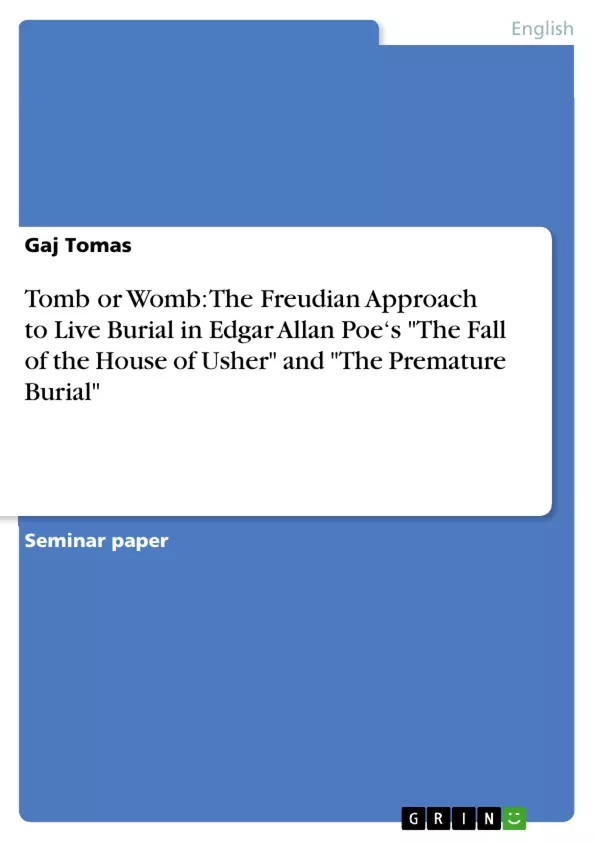There is a certain clever rhetoric from the buried protagonist in the introduction ―The
Premature Burial‖, Edgar Allan Poe‘s tale: ―The boundaries which divide Life from Death,
are at best shadowy and vague. Who shall say where the one ends, and the other begins?―
(Poe 322), as he finds himself ―buried‖ in what he believes to be a coffin, as the story starts to
intrigue us with one of the most terrifying and arguably uncanny experiences – live burial.
The narrator is obsessed, a walking ―dead man‖, who eventually saves himself from
the terrifying experience and exaggerated fear, but not from the uncanny feeling. It is as much
dreadful as when we as readers perceive the buried-alive Lady Madeline Usher breaking the
vault steel door of her coffin, uttering eerie sounds and appearing bloody at her brother
Roderick‘s door in Poe‘s even more gruesome tale, ―The Fall of the House of Usher‖. The
protagonists too are quite different, as are the representations of the motive of live burial in
both stories – one hand we deal with, as this essay will try and prove, an evident incestuous
relationship and perhaps Roderick‘s certain repressed wishes, and on the other hand the
exaggerated, almost satiric general fear of a seemingly cataleptic state and death.
Table of Contents
- Introduction
- Freudian's Approach to Reading Poe: Live Burial
- The Longing for the Womb in “The Fall of the House of Usher”
- Lady Madeline Usher as Freud's Uncanny Muse
- The Return of the Repressed and Breaking the Moral Order
- Repressed Wishes for Death in “Premature Burial”?
- Conclusion
Objectives and Key Themes
This essay analyzes Edgar Allan Poe's tales "The Fall of the House of Usher" and "The Premature Burial" through the lens of Sigmund Freud's theory of the uncanny. The essay aims to demonstrate that the terrifying experience of live burial, as portrayed in these tales, is not merely a fear of death but a psychological transformation of a repressed desire for a state of pre-birth existence, reminiscent of the mother's womb. By examining the role of the female genitals in Freudian theory, the essay explores how these tales delve into the unconscious mind of the protagonists, revealing their repressed desires and the complexities of the uncanny.
- The Freudian interpretation of the uncanny as a transformation of repressed desires.
- The connection between the uncanny and the familiar ("heimlich" and "unheimlich") in relation to the concept of the womb.
- The psychological motivations behind the characters' actions and the role of the repressed in shaping their experiences.
- The relationship between live burial and the concept of the "intra-uterine existence" as a source of both fear and desire.
- The role of the female genitals and the psychological transformation they represent in the context of live burial.
Chapter Summaries
The essay begins by introducing the concept of live burial as a terrifying and uncanny experience in Poe's tales. It then explores Freud's theory of the uncanny, highlighting the connection between the familiar and unfamiliar, and how the concept of the womb is intertwined with the uncanny experience of live burial.
The second chapter focuses on applying Freud's approach to the two tales. It examines the longing for the womb in "The Fall of the House of Usher" and the repressed desires in "The Premature Burial." The chapter analyzes the characters' psychological motivations and how they relate to Freud's concept of the uncanny.
Keywords
The essay's main keywords include: the uncanny, live burial, Freud, psychoanalysis, "heimlich," "unheimlich," intra-uterine existence, repressed desires, female genitals, psychological transformation, Edgar Allan Poe, "The Fall of the House of Usher," "The Premature Burial."
- Citar trabajo
- Gaj Tomas (Autor), 2011, Tomb or Womb: The Freudian Approach to Live Burial in Edgar Allan Poe‘s "The Fall of the House of Usher" and "The Premature Burial", Múnich, GRIN Verlag, https://www.grin.com/document/176926



